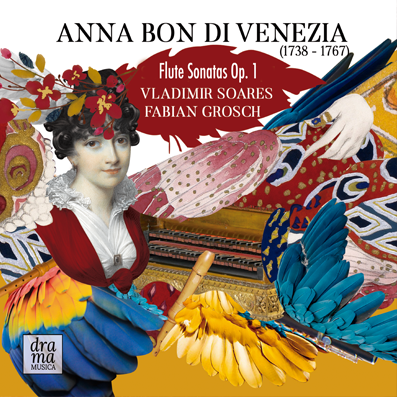
ANNA BON DI VENEZIA
6 Flute Sonatas Op. 1
During the eighteenth century music flourished in Italy and the impact of Italian musicians at courts all over Europe and further afield was testament to their remarkable prowess as performers and composers. Italy was enjoying a period of economic and political stability, which meant that all forms of music including vocal (both sacred and secular) and instrumental were being championed.
Many outstanding women scientists, scholars, artists, musicians and composers were found in Italy in the eighteenth century. One such female composer was Anna Bon from Venice. She was born in 1738 to a couple that both worked in opera productions. Her mother was a singer and her father worked as a librettist and set designer. At the age of four her parents enrolled her in the Ospedale Della Pietà in Venice as a tuition-paying pupil (figlia de spesi). Most of the children at the Ospedale were orphans but were exceptionally well trained in music. Francesco Gasparini was the continuo teacher at the Pietà for some time, Onofrio Penati taught woodwinds and for thirty-four years Antonio Vivaldi taught violin and viola in addition to composing for the girls.
Anna Bon studied at the Ospedale until the end of 1754, though she did leave periodically to tour with her parents as a musical prodigy. In 1755 her parents accepted a position within the Bayreuth-based court of Princess Wilhelmine of Prussia, older sister to King Frederick the Great of Prussia. The sixteen-year-old composer held the position of “chamber music virtuoso” and dedicated this first set of compositions Six Chamber Sonatas for flute and continuo, Op.1 (1756) to the flute-playing King. Two further collections of compositions appeared around this time; Six Sonatas for harpsichord Op.2 (1757) and Six Divertimenti (Trio Sonatas) for two flutes and continuo, Op.3 (1759). After Princess Wilhelmine died in 1758 Anna and her parents realised that they were no longer needed in Bayreuth and gradually returned to touring. In 1762 the family were employed in the court of Prince Nicolaus of Esterházy in Eisenstadt. Anna Bon may have left the Esterházy court in 1765 and she married an Italian singer in 1767. We know nothing more of her career or life after her marriage.
The Op.1 set of sonatas are presented here on the recorder instead of the flute, a substitution which was common practice in the eighteenth century, and they certainly convince in this new guise. It is clear from the outset that Bon knew of Frederick’s musical taste and technique. The sonatas contain extensive technical passages in the middle register with infrequent opportunities for breath. Catering to Frederick’s dislike for mournful or sad adagios, they tend to offer a more positive outlook with simple melodic lines that lend themselves to ornamentation. Phrase lengths are clearly defined; movements tend to be in binary form and each movement is thematically independent. With the exception of the Menuets, no dance titles are used, which was unusual for the time. These works have a sense of spontaneity, modulations are always logical and the tonal architecture clear and uncluttered. As a set of compositions they deserve to be better known and one hopes they will make it into more mainstream programmes as their simple yet charming message is communicated through this current recording.
© Ashley Solomon 2019
